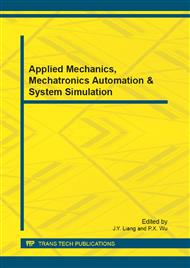[1]
Delorme, A. and J. Gautrais, et al. (1999). SpikeNET: A simulator for modeling large networks of integrate and fire neurons., Neurocomputing 26 : 989-996.
DOI: 10.1016/s0925-2312(99)00095-8
Google Scholar
[2]
Bower, J. M. and D. Beeman, et al. (1998). The book of GENESIS: exploring realistic neural models with the GEneral NEural SImulation System, Telos.
Google Scholar
[3]
Carnevale, N. T. and M. L. Hines (2006). The NEURON book, Cambridge Univ Pr.
Google Scholar
[4]
Bhalla, U. S. and D. H. Bilitch, et al. (1992). Rallpacks: a set of benchmarks for neuronal simulators., Trends in neurosciences 15 (11): 453-458.
DOI: 10.1016/0166-2236(92)90009-w
Google Scholar
[5]
Brette, R. and M. Rudolph, et al. (2007). Simulation of networks of spiking neurons: A review of tools and strategies., Journal of computational neuroscience 23 (3): 349-398.
Google Scholar
[6]
Markram, H. (2006). The blue brain project., Nature Reviews Neuroscience 7 (2): 153-160.
Google Scholar
[7]
Davison, A. P. and D. Br, et al. (2008). PyNN: a common interface for neuronal network simulators., Frontiers in neuroinformatics 2.
DOI: 10.3389/neuro.11.011.2008
Google Scholar
[8]
Gerstner, W. and W. M. Kistler (2002). Spiking neuron models, Cambridge University Press Cambridge, UK.
Google Scholar
[9]
Goodman, D. F. and R. Brette (2009). The Brian simulator., Frontiers in neuroscience 3 (2): 192.
Google Scholar
[10]
Izhikevich, E. M. (2004). Simple model of spiking neurons., Neural Networks, IEEE Transactions on 14 (6): 1569-1572.
DOI: 10.1109/tnn.2003.820440
Google Scholar
[11]
Maass, W. (1997). Networks of spiking neurons: the third generation of neural network models., Neural Networks 10 (9): 1659-1671.
DOI: 10.1016/s0893-6080(97)00011-7
Google Scholar
[12]
Vreeken, J. (2002). Spiking neural networks, an introduction., Institute for Information and Computing Sciences, Utrecht University Technical Report UU-CS-2003-008.
Google Scholar
[13]
Brette, R. (2007). Exact simulation of integrate-and-fire models with exponential currents., Neural Computation 19 (10): 2604-2609.
DOI: 10.1162/neco.2007.19.10.2604
Google Scholar
[14]
Brette, R. (2006). Exact simulation of integrate-and-fire models with synaptic conductances., Neural Computation 18 (8): 2004-(2027).
DOI: 10.1162/neco.2006.18.8.2004
Google Scholar
[15]
Pecevski, D. and T. Natschl, et al. (2009). PCSIM: a parallel simulation environment for neural circuits fully integrated with Python., Frontiers in neuroinformatics 3 . (2010). The FACETS Project.
DOI: 10.3389/neuro.11.011.2009
Google Scholar


